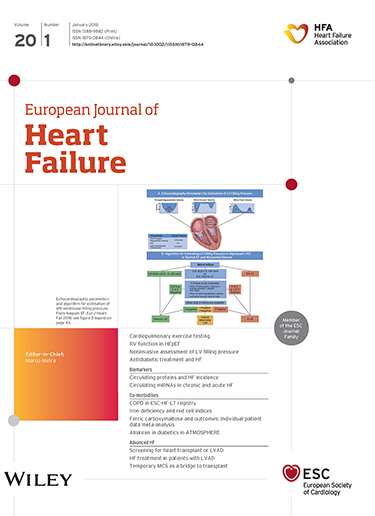Cardiac rhythm devices in heart failure with reduced ejection fraction – role, timing, and optimal use in contemporary practice. European Journal of Heart Failure expert consensus document
IF 16.9
1区 医学
Q1 CARDIAC & CARDIOVASCULAR SYSTEMS
引用次数: 0
Abstract
Guidelines for management of heart failure with reduced ejection fraction (HFrEF) emphasize personalized care, patient engagement, and shared decision‐making. Medications and cardiac rhythm management (CRM) devices are recommended with a high level of evidence. However, there are significant disparities: patients who could benefit from devices are frequently referred too late or not at all. Misconceptions about device therapy and the notion that the needs of patients (especially the prevention of sudden cardiac death) can now be met by expanding drug therapies may play a role in these disparities. This state‐of‐the‐art review is produced by members of the DIRECT HF initiative, a patient‐centred, expert‐led educational programme that aims to advance guideline‐directed use of CRM devices in patients with HFrEF. This review discusses the latest evidence on the role of CRM devices in reducing HFrEF mortality and morbidity, and provides practical guidance on patient referral, device selection, implant timing and patient‐centred follow‐up.心脏节律装置在心力衰竭与降低射血分数-作用,时间,并在当代实践的最佳使用。欧洲心力衰竭杂志专家共识文件
心力衰竭伴射血分数降低(HFrEF)的治疗指南强调个性化护理、患者参与和共同决策。药物和心律管理(CRM)设备被推荐与高水平的证据。然而,存在着显著的差异:可以从器械中获益的患者往往被转诊太晚或根本没有转诊。对器械治疗的误解和认为现在可以通过扩大药物治疗来满足患者的需求(特别是预防心源性猝死)的观念可能在这些差异中发挥作用。这篇最先进的综述是由DIRECT HF计划的成员制作的,这是一个以患者为中心、专家为主导的教育计划,旨在促进HFrEF患者在指南指导下使用CRM设备。这篇综述讨论了关于CRM设备在降低HFrEF死亡率和发病率方面作用的最新证据,并提供了关于患者转诊、设备选择、植入时间和以患者为中心的随访的实用指导。
本文章由计算机程序翻译,如有差异,请以英文原文为准。
求助全文
约1分钟内获得全文
求助全文
来源期刊

European Journal of Heart Failure
医学-心血管系统
CiteScore
27.30
自引率
11.50%
发文量
365
审稿时长
1 months
期刊介绍:
European Journal of Heart Failure is an international journal dedicated to advancing knowledge in the field of heart failure management. The journal publishes reviews and editorials aimed at improving understanding, prevention, investigation, and treatment of heart failure. It covers various disciplines such as molecular and cellular biology, pathology, physiology, electrophysiology, pharmacology, clinical sciences, social sciences, and population sciences. The journal welcomes submissions of manuscripts on basic, clinical, and population sciences, as well as original contributions on nursing, care of the elderly, primary care, health economics, and other related specialist fields. It is published monthly and has a readership that includes cardiologists, emergency room physicians, intensivists, internists, general physicians, cardiac nurses, diabetologists, epidemiologists, basic scientists focusing on cardiovascular research, and those working in rehabilitation. The journal is abstracted and indexed in various databases such as Academic Search, Embase, MEDLINE/PubMed, and Science Citation Index.
 求助内容:
求助内容: 应助结果提醒方式:
应助结果提醒方式:


